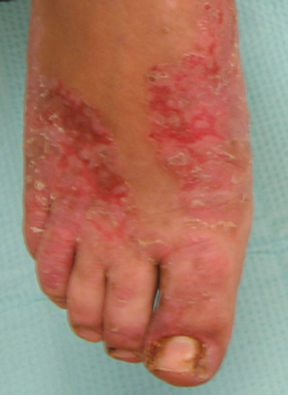Approach
Zinc deficiency can present in many ways and should be considered in people with at-risk conditions. Aside from the severe rash of acrodermatitis enteropathica seen in profound zinc deficiency, the manifestations of zinc deficiency are protean and non-specific. The diagnosis can be especially elusive because symptoms may overlap with the many conditions that predispose to zinc deficiency. For this reason, a high index of suspicion is critical.[Figure caption and citation for the preceding image starts]: Acrodermatitis enteropathica seen with severe zinc deficiencyAdapted from Maverakis E, Lynch PJ, Fazel N. Acrodermatitis enteropathica. Dermatol Online J. 2007;13:11; used with permission [Citation ends]. [Figure caption and citation for the preceding image starts]: Acrodermatitis enteropathica on the face seen with severe zinc deficiencyAdapted from Maverakis E, Lynch PJ, Fazel N. Acrodermatitis enteropathica. Dermatol Online J. 2007;13:11; used with permission [Citation ends].
[Figure caption and citation for the preceding image starts]: Acrodermatitis enteropathica on the face seen with severe zinc deficiencyAdapted from Maverakis E, Lynch PJ, Fazel N. Acrodermatitis enteropathica. Dermatol Online J. 2007;13:11; used with permission [Citation ends].
Clinical evaluation
Acquired zinc deficiency may result from poor nutritional intake, ingestion of foods or drugs that reduce zinc absorption, chronic illness, or any combination of these. Symptoms are quite diverse and clinical suspicion for this must be high in at-risk people. Acquired zinc deficiency can be seen in many patient groups. These include patients with malabsorption syndrome, chronic gastrointestinal (GI) and liver disease, renal disease, sickle cell disease, anorexia nervosa, and HIV infection; chronic treatment with certain medication (hydrochlorothiazide, penicillamine, ethambutol, certain antibiotics); and patients >65 years.[1][2][3][4][6][7][8][9][10][11][12][13] Zinc deficiency may contribute to many of the problems associated with ageing, including susceptibility to infection and osteoporosis.[14][15] Pica (clay eating) is common in children in some communities. Clay efficiently binds zinc, leading to dramatically decreased bioavailability.
Other risk factors include alcohol use disorder, vegetarianism or veganism, and living in a developing region.[5][31]
Low meat intake or high phytate/oxalate intake can contribute to zinc deficiency. Phytates and oxalates are found in many grain and vegetable products including soy, bran, whole grains, spinach, berries, chocolate, and tea. This is compounded by the tendency of diets low in meat to be high in the fibrous plant products that bind zinc, further limiting absorption.
Zinc is a key micronutrient important in growth and development, immune function, taste, smell, wound healing, protein synthesis, and maintenance of skin and hair. Some clinical features affected by zinc deficiency include:
Growth and development: impairment of growth, hypogonadism, osteopenia (increased risk of bone fracture), weight loss
Neurological: intention tremor, depression, impaired concentration, nystagmus, dysarthria, night blindness, hypogeusia, anosmia, dementia
Dermatological: alopecia, dermatitis, paronychia, stomatitis
Gastrointestinal: anorexia, abdominal pain, diarrhoea, glossitis
Miscellaneous: fatigue, delayed wound healing, fever, pica, increased infections, blepharitis, impaired glucose tolerance, infertility/adverse pregnancy outcomes, taste disorders.
Symptoms may overlap with the many conditions that predispose to zinc deficiency. Because there is such a non-specific presentation of zinc deficiency, it may be clinically difficult to differentiate from hypothyroidism and depression; other nutrient deficiencies that may co-exist with cases of zinc deficiency, including iron, vitamin D, vitamin A, vitamin B12, and folate, may also be difficult to differentiate. These deficiencies should be considered and tested for appropriately.
Acrodermatitis enteropathica is a manifestation of severe zinc deficiency typically caused by an autosomal-recessive disease, through impaired absorption. This disorder typically presents in infancy with crusting, vesicular dermatitis, diarrhoea, impairment of growth, and infections. However, acrodermatitis enteropathica may also rarely occur in adults with severe nutritional deficiency.[Figure caption and citation for the preceding image starts]: Acrodermatitis enteropathica seen with severe zinc deficiencyAdapted from Maverakis E, Lynch PJ, Fazel N. Acrodermatitis enteropathica. Dermatol Online J. 2007;13:11; used with permission [Citation ends]. [Figure caption and citation for the preceding image starts]: Acrodermatitis enteropathica on the face seen with severe zinc deficiencyAdapted from Maverakis E, Lynch PJ, Fazel N. Acrodermatitis enteropathica. Dermatol Online J. 2007;13:11; used with permission [Citation ends].
[Figure caption and citation for the preceding image starts]: Acrodermatitis enteropathica on the face seen with severe zinc deficiencyAdapted from Maverakis E, Lynch PJ, Fazel N. Acrodermatitis enteropathica. Dermatol Online J. 2007;13:11; used with permission [Citation ends].
Laboratory tests
If zinc deficiency is suspected, serum or plasma zinc testing should be done. Serum and plasma zinc levels are most commonly used and are the only tests available in routine clinical practice. Data support a level of <9.2 micromols/L (60 micrograms/dL) or <10.7 micromols/L (70 micrograms/dL) as abnormal in non-pregnant adults.[48] Owing to the relatively low sensitivity of serum zinc levels in marginal deficiency, oral supplementation should be considered if symptoms are typical, even if test results are normal.
Other nutrient deficiencies often co-exist with zinc deficiency. Deficiencies in iron, vitamin D, vitamin B12, and folate should be tested for. Deficiencies of other fat-soluble vitamins are relatively rare and hard to measure and thus, are not commonly tested.
In cases where zinc deficiency is due to dietary factors, no further evaluation is generally necessary. Evaluation for occult GI disease such as c0eliac disease or Crohn's disease is warranted if zinc deficiency is found in an individual without known risk factors.
Cell zinc content is an emerging test.
Because 95% of zinc is intracellular, zinc levels in a variety of cell populations (red blood cells, platelets, white blood cells) have been evaluated in research settings. Although cellular zinc levels fluctuate less than serum, they are technically more difficult than serum- or plasma-based tests, and superiority has not been clearly demonstrated.[49]
Diagnosis of acrodermatitis enteropathica is made initially through recognition of the typical clinical presentation, along with low serum or plasma zinc levels. Pathology of skin lesions is not pathognomonic and typically reveals psoriasiform dermatitis. Genetic testing may be done for mutations in the ZIP4 gene, but is not standard or available in all locations.
Use of this content is subject to our disclaimer